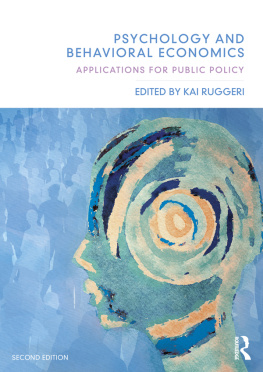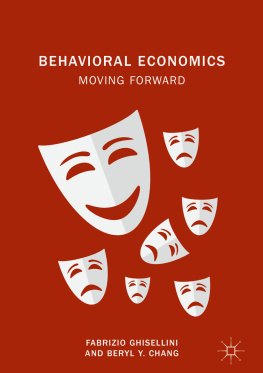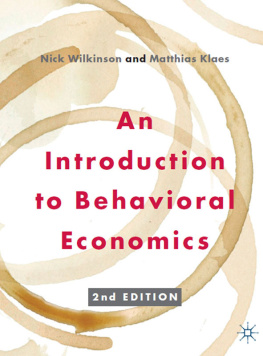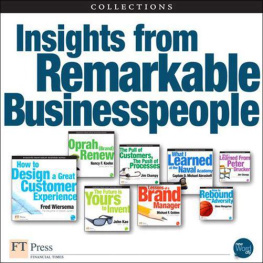Michael Hallsworth - Behavioral Insights
Here you can read online Michael Hallsworth - Behavioral Insights full text of the book (entire story) in english for free. Download pdf and epub, get meaning, cover and reviews about this ebook. year: 2020, publisher: MIT Press, genre: Politics. Description of the work, (preface) as well as reviews are available. Best literature library LitArk.com created for fans of good reading and offers a wide selection of genres:
Romance novel
Science fiction
Adventure
Detective
Science
History
Home and family
Prose
Art
Politics
Computer
Non-fiction
Religion
Business
Children
Humor
Choose a favorite category and find really read worthwhile books. Enjoy immersion in the world of imagination, feel the emotions of the characters or learn something new for yourself, make an fascinating discovery.

- Book:Behavioral Insights
- Author:
- Publisher:MIT Press
- Genre:
- Year:2020
- Rating:5 / 5
- Favourites:Add to favourites
- Your mark:
- 100
- 1
- 2
- 3
- 4
- 5
Behavioral Insights: summary, description and annotation
We offer to read an annotation, description, summary or preface (depends on what the author of the book "Behavioral Insights" wrote himself). If you haven't found the necessary information about the book — write in the comments, we will try to find it.
Behavioral Insights — read online for free the complete book (whole text) full work
Below is the text of the book, divided by pages. System saving the place of the last page read, allows you to conveniently read the book "Behavioral Insights" online for free, without having to search again every time where you left off. Put a bookmark, and you can go to the page where you finished reading at any time.
Font size:
Interval:
Bookmark:
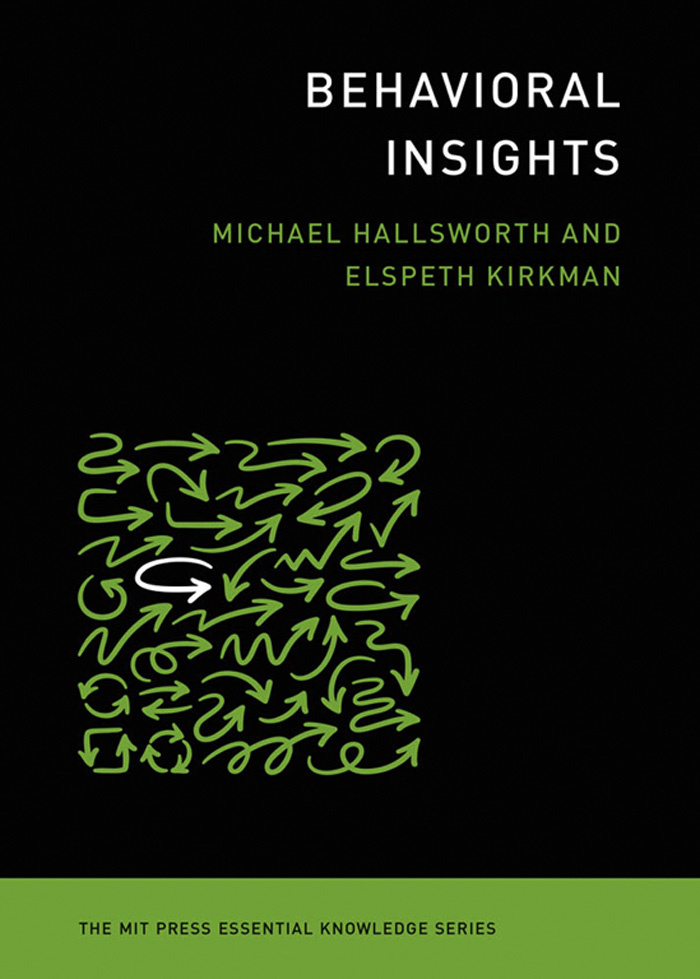
The MIT Press Essential Knowledge Series
A complete list of the titles in this series appears at the back of this book.
Michael Hallsworth and Elspeth Kirkman
The MIT Press | Cambridge, Massachusetts | London, England
2020 Massachusetts Institute of Technology
All rights reserved. No part of this book may be reproduced in any form by any electronic or mechanical means (including photocopying, recording, or information storage and retrieval) without permission in writing from the publisher.
This book was set in Chaparral Pro by New Best-set Typesetters Ltd.
Library of Congress Cataloging-in-Publication Data
Names: Hallsworth, Michael, author. | Kirkman, Elspeth, author.
Title: Behavioral insights / Michael Hallsworth and Elspeth Kirkman.
Description: Cambridge, Massachusetts : The MIT Press, [2020] | Series: The MIT press essential knowledge series | Includes bibliographical references and index.
Identifiers: LCCN 2020000394 | ISBN 9780262539401 (paperback)
Subjects: LCSH: Political planningPsychological aspects. | Social planningPsychological aspects. | Policy sciencesPsychological aspects. | Psychology, Industrial.
Classification: LCC HN28 .H28 2020 | DDC 361.1dc23
LC record available at https://lccn.loc.gov/2020000394
10 9 8 7 6 5 4 3 2 1
d_r0
The MIT Press Essential Knowledge series offers accessible, concise, beautifully produced pocket-size books on topics of current interest. Written by leading thinkers, the books in this series deliver expert overviews of subjects that range from the cultural and the historical to the scientific and the technical.
In todays era of instant information gratification, we have ready access to opinions, rationalizations, and superficial descriptions. Much harder to come by is the foundational knowledge that informs a principled understanding of the world. Essential Knowledge books fill that need. Synthesizing specialized subject matter for nonspecialists and engaging critical topics through fundamentals, each of these compact volumes offers readers a point of access to complex ideas.
Many of us have suddenly stopped and asked ourselves, Why did I just do that? We may have paused, looked around, and realized that we made it halfway home while our thoughts were elsewhere. Or maybe we sat next to a purchase that we now wonder if we really want or need, having been guided toward it effortlessly by prompts and reassurances.
These instances highlight that our behavior is often influenced by factors that lie outside our conscious awareness. This is not necessarily a problem; we would find it very hard to function if we had to consciously register and approve every single thing we do. But often we tend to underestimate the importance of this automatic side of our behaviorand so do governments or other organizations. The result may be ineffective policies, products, or plans.
The behavioral insights approach tries to address this problem by taking the latest evidence on what influences behavior, and then applying these insights to practical issues. Since the approach also prioritizes evaluating the impact of its interventions, we can know exactly how it has made a difference to tangible problems. As a result, the use of behavioral insights by governments, businesses, and individuals has exploded over the last ten years.
But there have also been many questions about whether the behavioral insights approach is a reliable one, whether it can tackle the big issues facing society, and whether it poses serious ethical questions. There is also much confusion about what the term behavioral insights actually means. This book addresses these questions by presenting the history, current practice, and future directions of behavioral insights.
Chapter 1 outlines the core features of the approach: a concern with practical issues; the use of evidence about human behavior to develop solutions for these issues; and the use of experimentation to evaluate the impact of these solutions. We show that this approach is best understood as a lens that allows us to see policies, programs, and services in a new light. Chapter 2 charts the history of the behavioral insights approach, which was born when three strands of thought came together: behavioral economics, dual-process theories in psychology, and a shift in how governments think about behavior. We explain how and why the period since 2010 has seen explosive growth in the use of the approach. Chapter 3 gives five brief examples of behavioral insights in practice.
Chapter 4 gives an overview of how to apply behavioral insights by working through a real example of increasing attendance at recruitment fairs by those looking for work. We include ten steps that cover identifying the scope and relevant behaviors, implementing and evaluating the intervention, and considering next steps. Chapter 5 is devoted to questions and criticisms. We consider the limitations of what the approach delivers on a practical level, including the longevity of its effects and its impact on high-level policy. We look at limitations of the relevant theories, and weaknesses in the evidence base. Finally, we consider whether the behavioral insights approach is ethical or acceptable. Chapter 6 looks to the future. We argue that in order to endure, the behavioral insights approach needs to consolidate and strengthen its evidence base and to prioritize new techniques and applications. Finally, it needs to integrate itself into standard practices for organizationsironically, true success may come when we stop talking about behavioral insights as a distinct idea.
We thank Owain Service, David Halpern, Luke Hydrick, and Adam Oliver for their comments on the manuscript for this book. We thank all our colleagues at the Behavioural Insights Team over the years. We thank Bob Prior for being a great editor, and the staff at the MIT Press for their production of the book.
Elspeth thanks Melanie Skipp-Kirkman for her patience and support while this book was being written (especially while she was heavily pregnant with our amazing daughter, Imogen, at the end!). She also takes this official opportunity to thank Sue, Alan, and Annie Kirkman for their lifelong support and love.
Michael thanks Ellen Hallsworth for all her guidance and encouragement, which were essential to the completion of the book, and Alice Hallsworth for being a welcome distraction from writing it. He also thanks Alan and Marion Hallsworth and Ceri Rahman for everything theyve done for him over the years.
The behavioral insights approach applies evidence about human behavior to practical problems. Behavioral insights can give a realistic account of how and why we act the way we do, allowing us to design or redesign policies, products, and services accordingly. The results of this approach have led to its adoption by governments, institutions, and businesses across the globe. This book explains the main principles of a behavioral insights approach, why it has proved so popular, and what it can achieve.
Lets start by discussing what is new about the approach: it offers a challenge to received wisdom about how decisions are made. Individuals, governments, and businesses often assume that our behavior is governed mostly by deliberate, considered reactions to the information and incentives we encounter. In this view, people take note of all relevant knowledge, carefully weigh up the costs and benefits of each available option, and make the choice that they think maximizes benefits to themselves (or those they care about).
Next pageFont size:
Interval:
Bookmark:
Similar books «Behavioral Insights»
Look at similar books to Behavioral Insights. We have selected literature similar in name and meaning in the hope of providing readers with more options to find new, interesting, not yet read works.
Discussion, reviews of the book Behavioral Insights and just readers' own opinions. Leave your comments, write what you think about the work, its meaning or the main characters. Specify what exactly you liked and what you didn't like, and why you think so.



